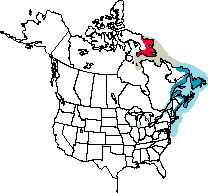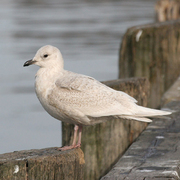Iceland Gull
The Washington representatives of this family can be split into two groups, or subfamilies. The adaptable gulls are the most familiar. Sociable in all seasons, they are mainly coastal, but a number of species also nest inland. Many—but not all—are found around people. Gulls have highly variable foraging techniques and diets. Terns forage in flight, swooping to catch fish or insects. They dive headfirst into the water for fish. Although they are likely to be near water, they spend less time swimming than gulls.
General Description
The Iceland Gull closely resembles Thayer’s Gull—in fact, the two have often been treated as geographic races of a single, though variable, species. Adults of both have a pale gray mantle. A classic adult Iceland Gull has all-white primaries and yellow eyes, and resembles a smaller, delicately built version of a Glaucous Gull. The “typical” adult Thayer’s Gull has brown eyes and shows some black on the upperside of the primary tips. However, individual birds can and do exhibit much overlap in these characteristics.
Only one of the two subspecies of Iceland Gull is regularly found in Canada and the United States—L.g. kumlieni, commonly known as Kumlien’s Gull. (The other subspecies, L.g. glaucoides, breeds in southern Greenland and winters in North Atlantic Europe.) Kumlien’s Gull breeds in the eastern Canadian Arctic, east and south of Thayer’s Gull with which it sometimes hybridizes where their ranges meet. Most Kumlien’s Gulls winter in Atlantic Canada and New England, with some straying down the Atlantic Coast and to the Midwest and small numbers farther west. The pattern is the opposite for Thayer’s Gull, which winters primarily along the West Coast with small numbers ranging across the continent as far as the Atlantic Coast.
Identification of Iceland Gull is a predictably contentious issue whenever one is claimed to have occurred within the core wintering range of Thayer’s Gull. Objections invariably raised include the difficulty or impossibility of correctly identifying hybrids, pale extremes of Thayer’s Gull, and birds in immature plumage or showing heavy feather wear or fading, as well as possible confusion with small individuals of Glaucous Gull. The Washington Bird Records Committee has accepted 11 records of Iceland (Kumlien’s) Gull—five from the eastside and six from the westside—while denying eight others. Records committees in nearby states and provinces have been more hesitant. Oregon has just two accepted records, as does California. The Idaho committee has accepted none of the ten reports it has received, although several of these remain under review. British Columbia has had many reports of Iceland Gull, but the review status of the species in the province is unclear.
Revised June 2007
North American Range Map


Family Members
 Laughing GullLarus atricilla
Laughing GullLarus atricilla Franklin's GullLarus pipixcan
Franklin's GullLarus pipixcan Little GullLarus minutus
Little GullLarus minutus Black-headed GullLarus ridibundus
Black-headed GullLarus ridibundus Bonaparte's GullLarus philadelphia
Bonaparte's GullLarus philadelphia Heermann's GullLarus heermanni
Heermann's GullLarus heermanni Black-tailed GullLarus crassirostris
Black-tailed GullLarus crassirostris Short-billed GullLarus canus
Short-billed GullLarus canus Ring-billed GullLarus delawarensis
Ring-billed GullLarus delawarensis California GullLarus californicus
California GullLarus californicus Herring GullLarus argentatus
Herring GullLarus argentatus Thayer's GullLarus thayeri
Thayer's GullLarus thayeri Iceland GullLarus glaucoides
Iceland GullLarus glaucoides Lesser Black-backed GullLarus fuscus
Lesser Black-backed GullLarus fuscus Slaty-backed GullLarus schistisagus
Slaty-backed GullLarus schistisagus Western GullLarus occidentalis
Western GullLarus occidentalis Glaucous-winged GullLarus glaucescens
Glaucous-winged GullLarus glaucescens Glaucous GullLarus hyperboreus
Glaucous GullLarus hyperboreus Great Black-backed GullLarus marinus
Great Black-backed GullLarus marinus Sabine's GullXema sabini
Sabine's GullXema sabini Black-legged KittiwakeRissa tridactyla
Black-legged KittiwakeRissa tridactyla Red-legged KittiwakeRissa brevirostris
Red-legged KittiwakeRissa brevirostris Ross's GullRhodostethia rosea
Ross's GullRhodostethia rosea Ivory GullPagophila eburnea
Ivory GullPagophila eburnea Least TernSternula antillarum
Least TernSternula antillarum Caspian TernHydroprogne caspia
Caspian TernHydroprogne caspia Black TernChlidonias niger
Black TernChlidonias niger Common TernSterna hirundo
Common TernSterna hirundo Arctic TernSterna paradisaea
Arctic TernSterna paradisaea Forster's TernSterna forsteri
Forster's TernSterna forsteri Elegant TernThalasseus elegans
Elegant TernThalasseus elegans

